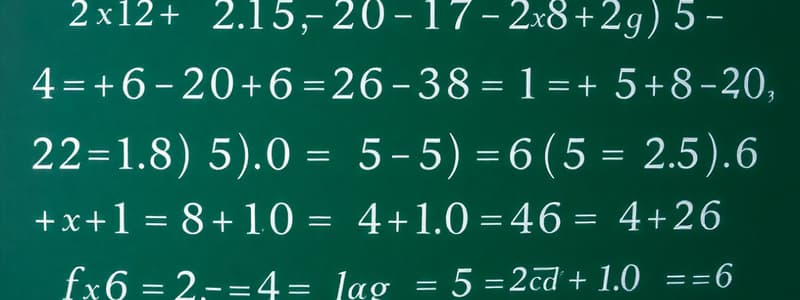Podcast
Questions and Answers
Which of the following best describes the relationship between the Greatest Common Divisor (GCD) and the Least Common Multiple (LCM) of two integers?
Which of the following best describes the relationship between the Greatest Common Divisor (GCD) and the Least Common Multiple (LCM) of two integers?
- The GCD is always greater than the LCM.
- The LCM is always a factor of the GCD.
- The GCD and LCM are always equal.
- The product of the GCD and LCM is equal to the product of the two integers. (correct)
A system of two linear equations has no solution. What does this indicate about the graphs of the two equations?
A system of two linear equations has no solution. What does this indicate about the graphs of the two equations?
- The lines are perpendicular.
- The lines intersect at a single point.
- The lines are parallel and distinct. (correct)
- The lines are coincident (the same line).
Given a right triangle, how does the Pythagorean theorem relate the lengths of its sides?
Given a right triangle, how does the Pythagorean theorem relate the lengths of its sides?
- The hypotenuse is equal to the average of the other two sides.
- The square of the hypotenuse is equal to the difference of the squares of the other two sides.
- The square of the hypotenuse is equal to the sum of the squares of the other two sides. (correct)
- The sum of all three sides equals the hypotenuse.
A function's derivative is zero at a certain point. What does this indicate about the function at that point?
A function's derivative is zero at a certain point. What does this indicate about the function at that point?
In statistics, what is the primary purpose of hypothesis testing?
In statistics, what is the primary purpose of hypothesis testing?
Which branch of mathematics deals primarily with the study of discrete, non-continuous mathematical structures?
Which branch of mathematics deals primarily with the study of discrete, non-continuous mathematical structures?
How do trigonometric functions relate angles to the sides of a right triangle?
How do trigonometric functions relate angles to the sides of a right triangle?
What is the main focus of Number Theory?
What is the main focus of Number Theory?
Why is understanding order of operations (PEMDAS/BODMAS) crucial in arithmetic?
Why is understanding order of operations (PEMDAS/BODMAS) crucial in arithmetic?
What is the relationship between exponential and logarithmic functions?
What is the relationship between exponential and logarithmic functions?
In Geometry, what distinguishes Euclidean geometry from other types of geometry?
In Geometry, what distinguishes Euclidean geometry from other types of geometry?
What does the Fundamental Theorem of Calculus establish?
What does the Fundamental Theorem of Calculus establish?
What is the difference between descriptive and inferential statistics?
What is the difference between descriptive and inferential statistics?
In Discrete Mathematics, what is the purpose of graph theory?
In Discrete Mathematics, what is the purpose of graph theory?
What is the unit circle primarily used for in Trigonometry?
What is the unit circle primarily used for in Trigonometry?
Why is prime factorization a fundamental concept in Number Theory?
Why is prime factorization a fundamental concept in Number Theory?
How can calculus be applied to optimize a real-world scenario?
How can calculus be applied to optimize a real-world scenario?
What role do transformations play in coordinate geometry?
What role do transformations play in coordinate geometry?
What is the significance of the 'domain' of a function?
What is the significance of the 'domain' of a function?
In statistics, what does correlation measure and what does a high correlation coefficient indicate?
In statistics, what does correlation measure and what does a high correlation coefficient indicate?
Flashcards
Arithmetic
Arithmetic
Deals with basic operations like addition, subtraction, multiplication, and division.
Algebra
Algebra
Uses symbols (variables) to represent unknown quantities and relationships.
Geometry
Geometry
Studies the properties and relationships of points, lines, angles, surfaces, and solids.
Calculus
Calculus
Signup and view all the flashcards
Statistics
Statistics
Signup and view all the flashcards
Discrete Mathematics
Discrete Mathematics
Signup and view all the flashcards
Trigonometry
Trigonometry
Signup and view all the flashcards
Number Theory
Number Theory
Signup and view all the flashcards
Order of Operations
Order of Operations
Signup and view all the flashcards
Greatest Common Divisor (GCD)
Greatest Common Divisor (GCD)
Signup and view all the flashcards
Least Common Multiple (LCM)
Least Common Multiple (LCM)
Signup and view all the flashcards
Linear Equations
Linear Equations
Signup and view all the flashcards
Quadratic Equations
Quadratic Equations
Signup and view all the flashcards
Functions
Functions
Signup and view all the flashcards
Area and Perimeter
Area and Perimeter
Signup and view all the flashcards
Derivatives
Derivatives
Signup and view all the flashcards
Integrals
Integrals
Signup and view all the flashcards
Descriptive Statistics
Descriptive Statistics
Signup and view all the flashcards
Probability
Probability
Signup and view all the flashcards
Algorithms
Algorithms
Signup and view all the flashcards
Study Notes
- Mathematics encompasses a vast and interconnected body of knowledge, including arithmetic, algebra, calculus, geometry, and statistics.
- It provides essential tools for problem-solving, logical reasoning, and quantitative analysis across diverse fields.
Arithmetic
- Arithmetic deals with basic operations: addition, subtraction, multiplication, and division.
- Number systems include integers, rational numbers (fractions), real numbers, and complex numbers.
- Order of operations (PEMDAS/BODMAS) dictates the sequence of calculations: parentheses, exponents, multiplication and division, addition and subtraction.
- Prime numbers are only divisible by 1 and themselves; composite numbers have more than two factors.
- The greatest common divisor (GCD) is the largest number that divides two or more integers without a remainder.
- The least common multiple (LCM) is the smallest number that is a multiple of two or more integers.
Algebra
- Algebra uses symbols (variables) to represent unknown quantities and relationships.
- Linear equations involve variables raised to the first power; solving them involves isolating the variable.
- Quadratic equations involve variables raised to the second power; they can be solved by factoring, completing the square, or using the quadratic formula.
- Systems of equations involve two or more equations with the same variables; solutions satisfy all equations simultaneously.
- Polynomials are expressions consisting of variables and coefficients, combined using addition, subtraction, and multiplication.
- Factoring polynomials involves expressing them as a product of simpler polynomials.
- Functions are relations that assign a unique output to each input; they can be represented graphically or algebraically.
- Domain of a function is the set of allowable inputs; the range is the set of corresponding outputs.
- Exponential functions involve a constant base raised to a variable exponent and model growth or decay.
- Logarithmic functions are the inverses of exponential functions and are used to solve exponential equations.
Geometry
- Geometry deals with the properties and relationships of points, lines, angles, surfaces, and solids.
- Basic shapes include triangles, squares, circles, cubes, spheres, pyramids, etc.
- Euclidean geometry is based on postulates by Euclid, including parallel postulate.
- Angles are measured in degrees or radians; complementary angles add up to 90 degrees, supplementary angles add up to 180 degrees.
- Triangles can be classified by their angles (acute, obtuse, right) or sides (equilateral, isosceles, scalene).
- The Pythagorean theorem relates the sides of a right triangle: a² + b² = c², where c is the hypotenuse.
- Area is the measure of the surface of a two-dimensional shape; perimeter is the distance around the boundary.
- Volume is the measure of the space occupied by a three-dimensional object; surface area is the total area of its surfaces.
- Coordinate geometry (analytic geometry) uses coordinates to represent geometric shapes and relationships.
- Transformations include translations, rotations, reflections, and dilations.
Calculus
- Calculus deals with rates of change and accumulation.
- Differential calculus focuses on derivatives, which measure the instantaneous rate of change of a function.
- Integral calculus focuses on integrals, which measure the accumulation of a quantity over an interval.
- Limits describe the behavior of a function as its input approaches a certain value.
- Derivatives are used to find maxima and minima of functions, as well as points of inflection.
- Integrals are used to calculate areas under curves, volumes of solids, and work done by a force.
- The fundamental theorem of calculus connects differentiation and integration.
- Techniques of integration include substitution, integration by parts, and partial fractions.
- Applications of calculus include optimization, related rates, and differential equations.
Statistics
- Statistics is the science of collecting, analyzing, interpreting, and presenting data.
- Descriptive statistics summarize and describe the main features of a dataset.
- Measures of central tendency include mean (average), median (middle value), and mode (most frequent value).
- Measures of dispersion include range (difference between max and min), variance, and standard deviation.
- Probability is the measure of the likelihood of an event occurring.
- Probability distributions describe the probabilities of different outcomes in a random experiment (e.g., normal distribution, binomial distribution).
- Inferential statistics uses sample data to draw conclusions about a population.
- Hypothesis testing involves formulating a null hypothesis and testing it against an alternative hypothesis.
- Regression analysis involves finding the relationship between a dependent variable and one or more independent variables.
- Correlation measures the strength and direction of a linear relationship between two variables.
Discrete Mathematics
- Discrete mathematics studies mathematical structures that are fundamentally discrete rather than continuous.
- Logic deals with reasoning and argumentation, including propositional logic and predicate logic.
- Set theory studies collections of objects (sets) and their properties.
- Relations define connections between elements of sets.
- Functions map elements from one set to another.
- Combinatorics deals with counting and arrangements of objects.
- Graph theory studies graphs, which are mathematical structures used to model pairwise relations between objects.
- Algorithms are step-by-step procedures for solving problems.
Trigonometry
- Trigonometry studies the relationships between angles and sides of triangles.
- Trigonometric functions include sine, cosine, tangent, cotangent, secant, and cosecant.
- These functions relate angles to ratios of sides in a right triangle.
- The unit circle provides a visual representation of trigonometric functions for all angles.
- Trigonometric identities are equations that are true for all values of the variables.
- The law of sines and the law of cosines relate the sides and angles of any triangle.
- Trigonometric equations involve finding the angles that satisfy a given equation.
- Applications of trigonometry include navigation, surveying, and physics.
Number Theory
- Number theory studies the properties of integers.
- Divisibility rules provide shortcuts for determining whether a number is divisible by another number.
- Prime factorization involves expressing a number as a product of prime numbers.
- Congruences relate integers that have the same remainder when divided by a given number.
- Diophantine equations are equations where the solutions are required to be integers.
- Cryptography utilizes number theory principles to create secure communication methods.
Studying That Suits You
Use AI to generate personalized quizzes and flashcards to suit your learning preferences.




